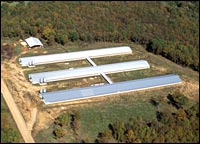While researching my Poverty & the Environment piece on the food system, I had occasion to look closely at the corn harvest, source of so much of our cheap food.
As bad as the annual flood of cheap corn is for our health — nutritionally worthless high-fructose corn syrup, cheap feed for confined animals pumped full of antibiotics and hormones — it may be even worse for the environment.Bolstered by government subsidies that have averaged about $4 billion annually since 1995, U.S. production accounts for nearly 40 percent of the world’s corn output. Every year, the USDA reports, corn farmers dump more than 10 billion pounds of nitrogen fertilizer onto their fields — a heavier dose than for any other crop by a factor of nearly three. (Source: Download table 2 from this USDA/Economic Research page.)
This annual cascade of “artificial fertility” (as the farmer and activist Jason McKenney calls it) parches soil of nitrogen-fixing bacteria. It crushes biodiversity and makes soils reliant on more fertilizer. According to McKenney, less than a fifth of that nitrogen makes it into corn plants.
The rest leeches into groundwater, feeding algae blooms that smother water-borne life from the northern reaches of the Mississippi River clear down to the Gulf of Mexico, where a dead zone about the size of New Jersey emerges each year, blotting out what was once a robust source of food and jobs, to say nothing of an important marine habitat. As Richard Manning puts it in the winter 2004 American Scholar (unavailable online):
Already, the Dead Zone has seriously damaged what was once a productive fishery, meaning that a high-quality source of low-cost protein is being sacrificed so that a source of low-quality, high-input subsidized protein can blanket the Upper Midwest.
In a sense, by ending up in the Gulf, that fertilizer is coming home: nitrogen-based fertilizer derives from natural gas.
What do we get for this taxpayer-funded, soil-and-marine-life destroying harvest? For one thing, we get way too much corn.
In 2004, U.S. farmers produced a mind-numbing 11.8 billion bushels of corn (a bushel equals 56 pounds). Even given such dubious government-generated uses as ethanol and high-fructose corn syrup, even with the NAFTA-sanctioned dumping of cheap U.S. corn on the Mexican market, they only managed to sell 10.8 billion bushels.
For this feat of overproduction, the government paid them $4.5 billion.
Let’s be clear here. The great bulk of farms are being left off of this gravy train. Environmental Working Group reckons that in 2004, 20 percent of subsidized corn farms received 80 percent of that $4 billion payout. A few big farms are grabbing most of the cheese.
The real beneficiaries of this twisted system aren’t most corn growers; it’s the buyers, processing giants like Archer Daniels Midland and Cargill. That one-billion-bushel surplus of corn in 2004 exerted enormous downward pressure on corn prices. In 2004, a bushel — 56 pounds — of corn brought in $1.95 to the farmer. That’s about 3 cents a pound. At that rate, the only way a farm can make any money at all is to scale up as much as possible and then hope for a government check. No wonder mid-sized farms are rapidly going extinct.
Archer Daniels Midland makes a killing off of our cheap-food system; a few mega-farms in the Midwest do OK as well. But for most people, and for the environment, what we get is a government-underwritten disaster.
I can’t imagine a better place for greens, social-justice activists, and real-food enthusiasts to unite for change.



